The hip-hop culture , born in the South Bronx in New York at the end of the 1960s and the beginning of the 1970s, is one of the most influential cultural movements of the 20th century.
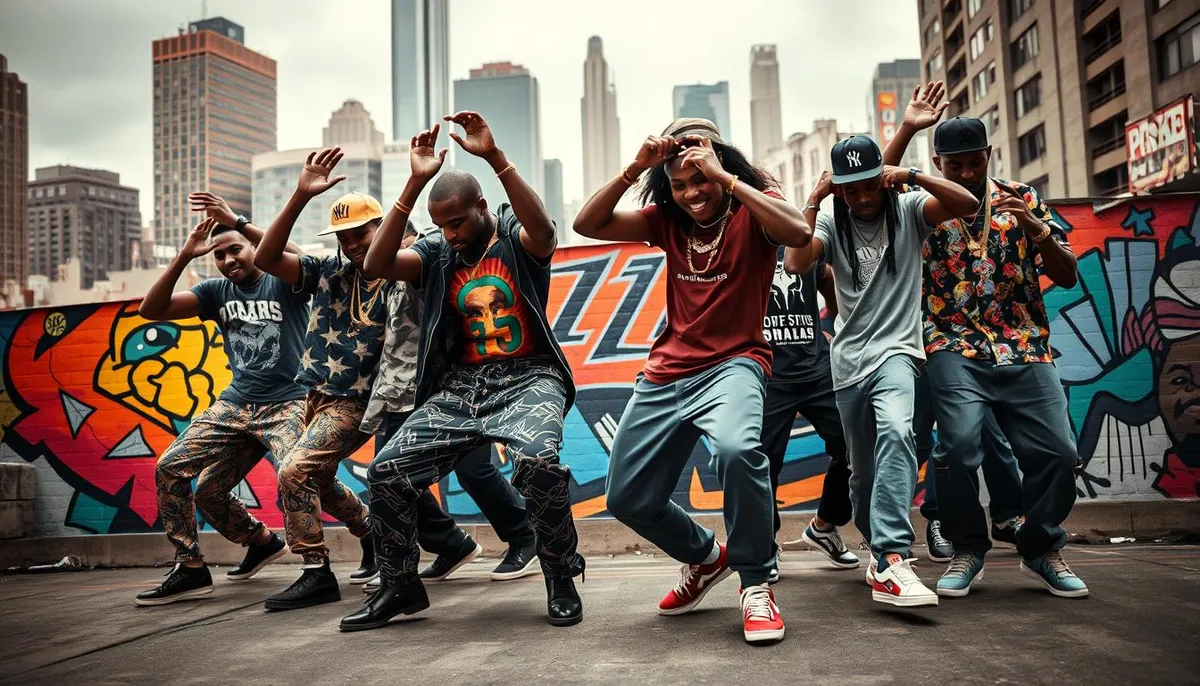
This cultural movement has been defined by five fundamental pillars: MCing/rap, DJing, breakdancing, graffiti, and beatboxing. Together, these elements have shaped a unique identity that has transcended borders and generations.
The global influence of hip-hop culture on music, fashion, art, and social movements is undeniable. From its local origins in New York to its global expansion, hip-hop continues to evolve, influencing new generations of artists and fans.
The Origins of Hip Hop Culture
The birth of hip-hop culture is closely tied to the difficult socio-economic conditions of the Bronx in the 1970s. This period was marked by a severe economic crisis, high unemployment rates, and exacerbated racial discrimination.
Birth in the South Bronx
The hip-hop movement was born in the South Bronx, a neighborhood in New York that had been ravaged by deindustrialization and urban neglect. Young African Americans and Latino Americans in this neighborhood found in hip-hop a form of expression and resistance to their situation.
Living conditions in the ghetto of the Bronx were extremely difficult. Poverty, unemployment, and violence were omnipresent. However, it was in this context of great adversity that hip-hop culture began to take shape.
- Parties organized by DJs like DJ Kool Herc played a crucial role in the emergence of hip-hop.
- Breakdancing and graffiti became key elements of this new culture.
- Rap, as a form of vocal expression, allowed young people to tell their stories and struggles.
Social and Economic Context of the 1970s
The 1970s were a period of great economic and social turbulence in the United States. The economic crisis of 1973 had devastating effects on urban communities, particularly in the Bronx.
Deindustrialization and the loss of manufacturing jobs left many people unemployed. The situation was further aggravated by urban policies that led to the demolition of many housing units, leaving residents homeless.
The 1977 blackout in New York contributed to the spread of DJ equipment and, by extension, hip-hop culture. Young people began to take ownership of the streets and public spaces, creating a new urban culture.
- The economic crisis pushed young people to seek alternatives to gang violence.
- Hip-hop became a form of cultural resistance to social and economic injustices.
- Hip-hop artists used their music and art to denounce living conditions in the ghettos. Additionally, initiatives like bimpli cultural gift vouchers have emerged to support cultural engagement and provide opportunities for youth in these communities.
The Five Pillars of Hip Hop Culture
Hip-hop consists of five major pillars that shape its musical, artistic, and cultural landscape. These fundamental elements are essential for understanding the richness and diversity of this urban culture.
MCing/Rap: Vocal Expression
MCing, or rap, is one of the most characteristic forms of expression in hip-hop. It is a vocal expression that combines rhythmic lyrics with elements of poetry and storytelling. Rappers use various techniques such as rhyme, alliteration, and assonance to create engaging and impactful lyrics.
Rap has evolved over the years, integrating different styles and themes. It has become a powerful means for artists to express themselves on social, political, and personal issues.
DJing and Turntablism
DJing is another essential pillar of hip-hop, involving the manipulation of vinyl or digital files to create music. DJs use mixing and scratching techniques to produce unique and rhythmic sounds.
Turntablism, an advanced form of DJing, involves using two turntables to create complex beats and samples.
Breakdance: Physical Expression
Breakdancing is a dynamic dance that is an integral part of hip-hop culture. It is characterized by acrobatic movements, floor figures, and spins. B-Boys and B-Girls use their bodies to express music and tell stories through dance.
Graffiti: Urban Visual Art
Graffiti is a form of visual art that developed on the streets of cities. Graffiti artists use various techniques, ranging from spray paint to murals, to create works that reflect their worldview.
Beatboxing: Vocal Percussion
Beatboxing is the art of creating rhythms and percussive sounds with the mouth, lips, and voice. This technique allows artists to produce complex beats without instruments.
Beatboxers use various techniques to imitate drum sounds and create varied rhythms. Beatboxing has become an integral part of hip-hop performances, offering an accessible alternative to traditional instruments.
| Pillar | Description | Characteristics |
|---|---|---|
| MCing/Rap | Vocal expression | Rhymes, alliterations, assonances |
| DJing/Turntablism | Sound manipulation | Mixing, scratching |
| Breakdance | Physical expression | Acrobatic movements, floor figures |
| Graffiti | Urban visual art | Spray paint, murals |
| Beatboxing | Vocal percussion | Percussive sounds, varied rhythms |
The Evolution of Hip Hop Music Through the Decades
Since its origins, hip-hop has undergone a significant transformation, evolving from a local musical style to a global culture. This evolution has been marked by periods of intense creativity and iconic figures who have contributed to shaping contemporary music and culture.
The Pioneers of the 1970s
The 1970s were crucial for the development of hip-hop. It was during this decade that the foundations of hip-hop culture were established.
DJ Kool Herc and the Block Parties
DJ Kool Herc is often credited as one of the pioneers of hip-hop. His block parties, where he experimented with mixing techniques and extended breaks, laid the groundwork for hip-hop.
Afrika Bambaataa and the Zulu Nation
Afrika Bambaataa, with the Zulu Nation, played a key role in organizing the first hip-hop communities. He helped structure the movement and promote hip-hop culture.
The Golden Age of the 1980s
The 1980s are often considered the golden age of hip-hop. This period saw the emergence of groups and artists who popularized hip-hop beyond the borders of New York.
The New School and Run-DMC
Run-DMC was one of the first hip-hop groups to achieve commercial success. Their unique style and energetic lyrics helped popularize hip-hop among a wider audience.
The Emergence of Sampling and Drum Machines
The use of sampling and drum machines revolutionized hip-hop music production in the 1980s. These technologies allowed producers to create new sounds and push the boundaries of musical creativity.
Hip Hop in the 1990s: Between Mainstream and Underground
The 1990s saw hip-hop divide between the mainstream and the underground. This decade was marked by debates about the authenticity and commercialization of hip-hop culture.
The East Coast/West Coast Rivalry
The rivalry between the East Coast and West Coast of the United States dominated hip-hop in the 1990s. This rivalry had significant implications for the music and artists of the time.
Gangsta Rap and Its Social Impact
Gangsta rap, with artists like Tupac Shakur and The Notorious B.I.G., had a profound impact on society. The raw and realistic lyrics highlighted the realities of life in urban ghettos.
The Global Expansion of the 2000s
The 2000s saw hip-hop become a global cultural phenomenon. Artists like Eminem, Jay-Z, 50 Cent, and Kanye West dominated global charts.
- Analysis of the globalization of hip-hop in the 2000s, which became a global cultural phenomenon.
- Presentation of American artists who dominated the global scene.
- Exploration of the emergence of local hip-hop scenes in different countries.
- Description of the impact of the internet and new technologies on the dissemination and production of hip-hop music.
- Analysis of the evolution of hip-hop sound in the 2000s, with the emergence of new sub-genres.
The hip-hop of the 2000s also saw the emergence of new sub-genres such as crunk, trap, and dirty south, enriching the musical diversity of the genre.
In summary, the evolution of hip-hop music through the decades has been marked by periods of intense creativity, iconic figures, and technological changes. The benefits of the illicado culture card have also played a role in this evolution, as hip-hop has become a global cultural phenomenon, influencing music, fashion, and society worldwide.
The Iconic Figures of Hip Hop
The hip-hop culture is rich in iconic figures who have shaped its identity and evolution. These personalities, whether DJs, MCs, producers, or groups, have all contributed to making hip-hop as vibrant and diverse as it is today.
The Revolutionary DJs
DJs have played a crucial role in the emergence and evolution of hip-hop. Pioneers like DJ Kool Herc and Grandmaster Flash innovated in mixing and scratching techniques, creating the foundations of hip-hop music. Their influence has been felt well beyond the early days of the culture, continuing to inspire new generations of DJs.
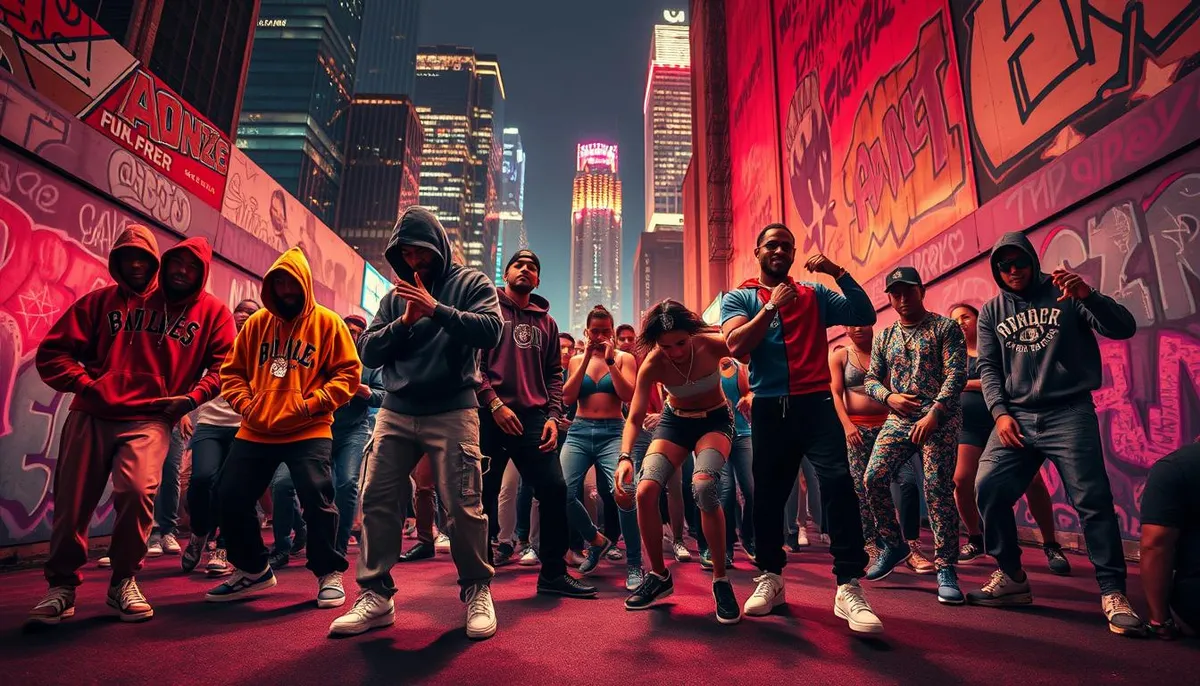
The Legendary MCs
MCs, or rappers, have been at the heart of the vocal expression of hip-hop. Legends like Tupac Shakur and The Notorious B.I.G. have made history with their powerful lyrics and unique flow. Others, like Nas and Jay-Z, have continued to evolve the art of rap, pushing the boundaries of creativity and expression.
The Visionary Producers
Hip-hop producers have been the sonic architects of the culture, creating beats and melodies that have defined the various currents of the genre. Producers like Dr. Dre and The Alchemist have innovated in production, bringing a new sonic dimension to hip-hop.
The Groups That Made History
Some hip-hop groups have left an indelible mark on the culture. Run-DMC, for example, was one of the first groups to achieve major commercial success, breaking down barriers between rap and rock. Public Enemy revolutionized the genre with its politically charged lyrics and dense sound. The Wu-Tang Clan redefined the group approach in hip-hop with its universe inspired by kung-fu films.
Other groups, such as A Tribe Called Quest, De La Soul, and The Roots, have expanded the musical horizons of hip-hop by incorporating elements of jazz and soul, thus enriching the diversity of the genre.
These iconic figures, whether DJs, MCs, producers, or groups, have all contributed to the success and richness of hip-hop culture. Their influence continues to be felt today, making hip-hop a dynamic and ever-evolving genre.
Hip Hop Culture and Its Influence on Fashion
The influence of hip-hop culture on fashion is a complex phenomenon that blends appropriation and collaboration. Since the early days of hip-hop, fashion has played a crucial role in expressing the identity and creativity of artists and their communities.
The Fashion Aesthetic of the 1980s
The 1980s saw the emergence of a distinctive hip-hop style, characterized by baggy and comfortable clothing, high-top sneakers, and flashy accessories. Brands like Adidas and Nike became staples of hip-hop fashion.
The Evolution of Hip Hop Style in the 1990s
In the 1990s, hip-hop style continued to evolve, with the emergence of new trends and the growing influence of artists on fashion. Clothing labels like Jay-Z's Rocawear and Diddy's Sean John popularized hip-hop style on a global scale.
The Impact of Hip Hop on Major Fashion Brands
The influence of hip-hop on major fashion brands has been significant, with collaborations between hip-hop artists and luxury designers. Partnerships like that between Kanye West and Adidas, or Rihanna and Puma, have marked the fashion industry.
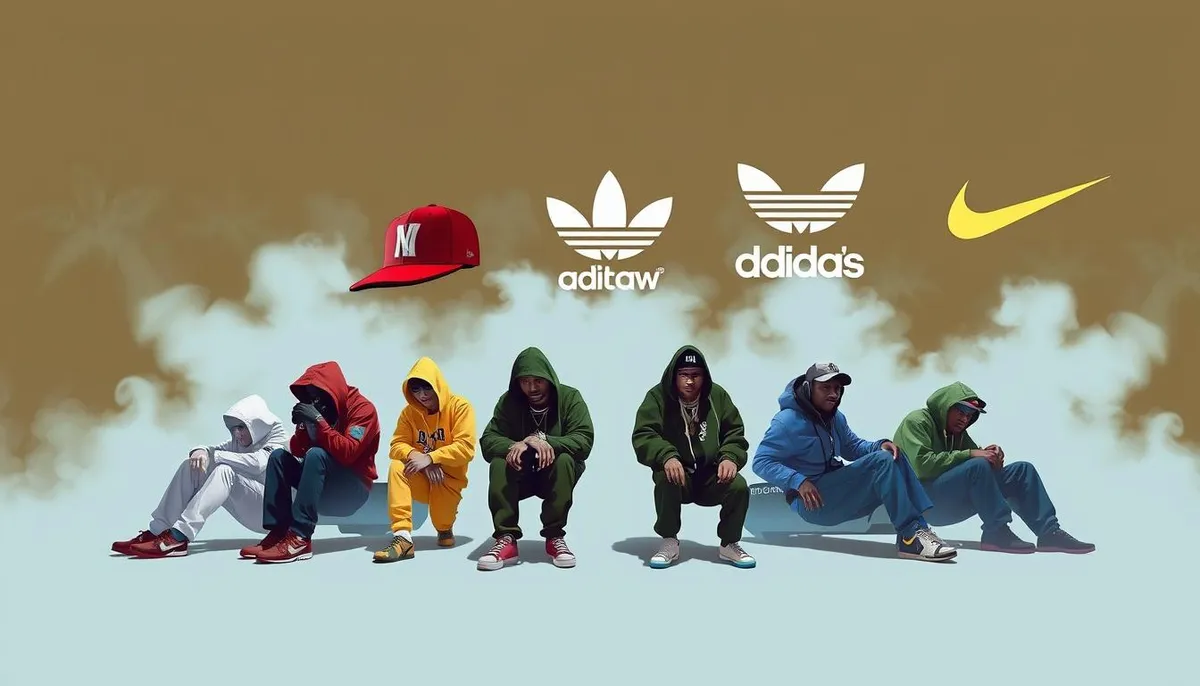
Hip-hop culture has democratized luxury fashion by introducing streetwear elements into high fashion collections. This fusion has allowed major brands to reconnect with the street and remain relevant in an ever-evolving market.
Hip Hop as a Social and Political Movement
Hip-hop is more than just a musical genre; it is a movement that conveys powerful messages about society and politics. Since its emergence in the 1970s, it has played a crucial role in expressing social struggles and political realities.
The Message Behind the Lyrics
The lyrics of hip-hop songs often carry social and political messages. Artists use their music to denounce injustices, express their frustrations with difficult socio-economic conditions, and call for collective action.
For example, artists like Kendrick Lamar and J. Cole have used their platforms to address issues such as systemic racism, police brutality, and economic inequalities. Their messages resonate with a broad audience, inspiring reflection and engagement.
The Social Engagement of Hip Hop Artists
In addition to their musical messages, many hip-hop artists are actively engaged in social and humanitarian initiatives. They create foundations, support social causes, and participate in programs aimed at improving living conditions in their communities.
Artists like Common, J. Cole, and Chance the Rapper are known for their commitment to causes such as education, violence prevention, and prison reform. Their efforts help promote positive values and counterbalance the negative stereotypes associated with hip-hop culture.
| Artist | Initiative | Goal |
|---|---|---|
| Jay-Z | Sean Carter Foundation | Education and support for families |
| Tupac Shakur | Tupac Amaru Shakur Foundation | Arts and culture for youth |
| Chance the Rapper | Chicago Public Schools | Improvement of public education |
The impact of these initiatives is significant, bringing positive changes to communities and reinforcing the image of hip-hop as a force for social change.
The Influence of Hip Hop on Other Musical Genres
Hip-hop has significantly influenced various musical genres over the years, marking a new wave of creativity. This influence manifests itself through collaborations with other musical styles and the emergence of new hybrid genres.
Collaborations with Rock and Pop
Hip-hop has fused with rock and pop to create unique sounds. Groups like Rage Against the Machine and Limp Bizkit have popularized rap-rock and nu-metal, blending the energy of hip-hop with the intensity of alternative rock.
- Rage Against the Machine revolutionized the music scene with their aggressive guitar riffs and engaged lyrics.
- Limp Bizkit brought a more accessible touch to nu-metal, reaching a wider audience.
These collaborations show how hip-hop can enrich other genres by bringing a new rhythmic dimension and impactful lyrics.
The Emergence of Hybrid Genres
The influence of hip-hop has also led to the emergence of hybrid genres. Trip-hop, for example, combines elements of hip-hop, electronic music, and soul. Artists like Massive Attack and Portishead developed this style in the UK, characterized by dark atmospheres and slow rhythms.
Moreover, contemporary R&B has been heavily influenced by hip-hop. Artists like The Weeknd, Frank Ocean, and SZA have incorporated hip-hop elements into their music, creating a modern and innovative sound.
- The Weeknd has fused R&B and hip-hop to create hits like “The Hills.”
- Frank Ocean brought a hip-hop touch to his album “Blonde,” with tracks like “Nikes.”
- SZA blended R&B and hip-hop in her album “Ctrl,” receiving critical acclaim.
These hybrid genres testify to hip-hop's ability to constantly reinvent itself by absorbing and transforming other musical influences.
Hip Hop in France: A Unique History
French hip-hop has a rich and complex history, shaped by unique cultural and social influences. Since its emergence in the 1980s, this urban culture has evolved to become an essential part of the French musical and artistic scene.
The Beginnings with Sidney's H.I.P. H.O.P. Show
One of the first manifestations of hip-hop in France was the television show “H.I.P. H.O.P.” hosted by Sidney. This show, broadcast in the 1980s, played a crucial role in popularizing hip-hop among the general public. It introduced the French to various aspects of hip-hop culture, including rap, breakdancing, and graffiti.
With “H.I.P. H.O.P.,” Sidney not only showcased emerging artists but also helped create a community around this new culture. The show served as a platform for young talents, allowing them to gain recognition and share their passion for hip-hop.
The Emergence of French Rap in the 1990s
The 1990s marked a turning point for French rap. Groups like NTM and IAM began to gain popularity, bringing with them engaged lyrics and catchy rhythms. French rap started to stand out with its creative use of language, mixing slang, verlan, and literary references.
This decade also saw the emergence of independent labels that supported local artists and contributed to the diversification of the French hip-hop scene. The social and political message became increasingly present in the lyrics, reflecting the concerns of young people from immigrant backgrounds and suburbs.
The Specificities of French Hip Hop
French hip-hop is distinguished by its linguistic richness and its ability to integrate diverse musical influences, including organic agriculture themes. Lyricism, African and Maghrebian music have nourished French hip-hop, giving it a unique identity.
The question of identity, integration, and social inequalities is at the heart of the message of French hip-hop. Artists use their platform to address these sensitive issues and to express the realities of life in the suburbs.
| Characteristics | Description | Influence |
|---|---|---|
| Linguistic Richness | Use of slang, verlan, and literary references | Gives a unique identity to French rap |
| Musical Influences | Lyrical song, African and Maghrebian music | Enriches the musical diversity of French hip-hop |
| Social Message | Addresses themes such as identity, integration, and inequalities | Reflects social realities and gives a voice to communities |
French hip-hop has managed to create its own identity while remaining connected to the developments of the international scene. This ability to balance local authenticity and global influences is one of the keys to its success.
Hip Hop Culture in the Media and Entertainment
Hip-hop culture has transcended its origins to become a dominant force in various media and entertainment around the world. This influence is significantly manifested in cinema, television, series, and video games, demonstrating the reach and flexibility of hip-hop culture. The influence of social media has also played a crucial role in amplifying this impact, allowing hip-hop artists to connect with their audiences in unprecedented ways.
Hip Hop in Cinema
Hip-hop made its entry into cinema as early as the 1980s, with films like “Wild Style” and “Beat Street” capturing the essence of the emerging hip-hop culture. Since then, hip-hop has become an essential element of cinema, influencing not only soundtracks but also storytelling and aesthetics of films.
Films like “8 Mile” featuring Eminem showed how hip-hop could be used to tell powerful and authentic stories. Hip-hop in cinema has opened new avenues for representation and artistic expression.
The Impact on Television and Series
The influence of hip-hop also extends to television and series, where it is often used to reflect urban reality and the concerns of young people. Series like “Empire” have highlighted hip-hop and R&B music, influencing musical trends and popular culture.
Television and series have provided a platform for hip-hop artists, allowing them to reach a wider audience. This has contributed to the dissemination of hip-hop culture beyond its roots.
Video Games and Hip Hop Culture
Video games have played a crucial role in integrating hip-hop culture into modern entertainment. Games like “Def Jam: Fight for NY” and “DJ Hero” have allowed players to immerse themselves in the hip-hop universe, whether through music or street fights.
- Hip-hop-centered video games, like “Def Jam” or “DJ Hero,” offer an immersive experience.
- The influence of hip-hop on the soundtracks of popular games like “Grand Theft Auto” helps to spread this music globally.
- Collaborations between the video game industry and hip-hop artists, such as 50 Cent with “50 Cent: Blood on the Sand,” show the fruitful intersection between hip-hop and video games.
In summary, hip-hop culture has profoundly influenced media and entertainment, bringing a new dimension to storytelling, music, and user experience. Video games, in particular, have helped normalize and globalize hip-hop culture among younger generations, ensuring its continued relevance in the global cultural landscape.
The Entrepreneurial Aspect of Hip Hop
Hip-hop has evolved beyond its musical roots to become an entrepreneurial phenomenon. Hip-hop artists are no longer just creating music; they are building businesses, brands, and commercial empires.
From Independent Labels to Commercial Empires
Independent hip-hop labels were the first steps toward entrepreneurship in this industry. Pioneers like Russell Simmons with Def Jam paved the way. Def Jam became a model for independent labels, showing that it was possible to succeed without the support of major labels.
The success of Def Jam inspired a new generation of hip-hop entrepreneurs. They created their own labels, producing not only music but also clothing, accessories, and even beverages.
Hip Hop Artists Turned Businesspeople
Some hip-hop artists have transcended their status as musicians to become influential entrepreneurs. Jay-Z is a perfect example, having invested in various sectors such as music with Roc Nation, music streaming with Tidal, and even champagne with Armand de Brignac.
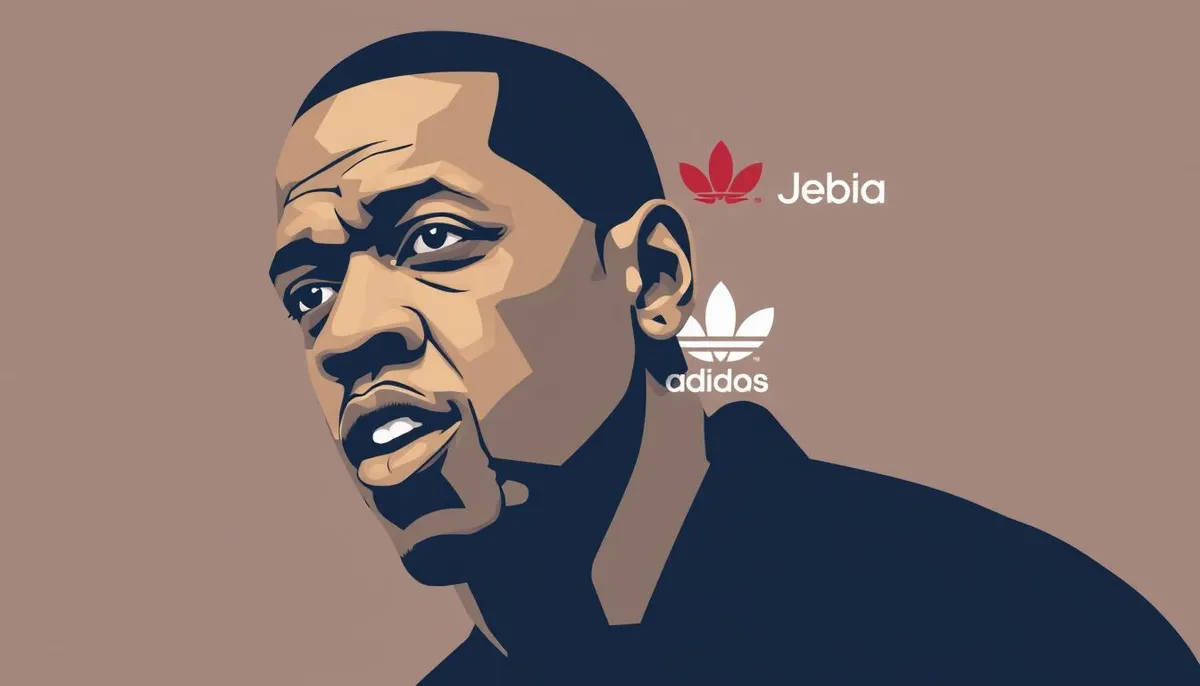
Another notable example is Dr. Dre with Beats Electronics, which was sold to Apple for 3 billion dollars. These success stories show how hip-hop artists can succeed in various fields, creating new economic opportunities.
These hip-hop entrepreneurs have not only succeeded personally but have also had a significant impact on hip-hop culture and on the perception of economic success possibilities for artists from disadvantaged backgrounds.
Graffiti: From Street Art to Artistic Recognition
Since its beginnings in the 1970s, graffiti has come a long way toward artistic recognition. Initially perceived as an act of vandalism, this form of urban expression has evolved to become an essential component of hip-hop culture .
Evolution of Techniques and Styles
The evolution of graffiti has been marked by various styles and techniques. Artists began by using spray paint to tag walls and subway trains in New York. Over time, techniques diversified, incorporating new materials and methods.
Some artists specialized in complex styles, such as “wildstyle” or “throw-ups,” while others explored more narrative or abstract forms. This diversity has contributed to enriching the urban landscape and expanding the recognition of graffiti as an art.
| Period | Dominant Style | Characteristics |
|---|---|---|
| 1970s | Tagging | Simple, names or initials |
| 1980s | Wildstyle | Complex, interwoven letters |
| 1990s | Street Art | Stencils, influence of urban art |
From the Walls of the Bronx to Art Galleries
Graffiti has gradually gained recognition, moving from the walls and subways of New York to international art galleries and museums. Pioneering exhibitions like “New York/New Wave” at the P.S.1 Contemporary Art Center in the 1980s played a crucial role in this transition.
Galleries like Fashion Moda and Fun Gallery were among the first to showcase artists from graffiti, providing them with a platform to reach a wider audience. Artists like Jean-Michel Basquiat, Keith Haring, and Futura2000 achieved international success, contributing to the legitimization of graffiti in the world of art.
However, this recognition has also sparked debates about the authenticity and commercial appropriation of this form of art. Some fear that the integration of graffiti into the art market may strip it of its contestatory and subversive essence.
Breakdance: From the Streets to International Competitions
Breakdance, a dance born in the streets of the Bronx, has evolved into international competitions, captivating an increasingly broad audience. This evolution reflects not only the growth of hip-hop culture but also the recognition of breakdance as a form of art and sport.
The Battles and Their Importance in Hip Hop Culture
Breakdance battles, or “cyphers,” are at the heart of hip-hop culture. They represent an arena where dancers, known as b-boys and b-girls, challenge each other by executing complex and spectacular movements. These local competitions have played a crucial role in the evolution of breakdance, encouraging innovation and creativity.
Over time, these battles have gained popularity, attracting participants and spectators from around the world. They are now an integral part of hip-hop events, demonstrating the vitality and diversity of this culture.
The Evolution of B-Boying and B-Girling
Since its beginnings in the 1970s, breakdance has gone through several phases of evolution. The 1980s saw its popularization through films like “Wild Style” and “Breakin’.” The 1990s and 2000s were marked by a relative decline, followed by a renaissance partly due to globalization and the influence of social media.
Today, breakdance continues to evolve, with the emergence of distinctive national styles in Korea, Japan, France, and Brazil. The inclusion of breakdance in the Paris 2024 Olympics is a historic moment, promising to give new visibility to this dance and encourage a new generation of dancers.
| Period | Event/Evolution | Impact |
|---|---|---|
| 1970s | Birth of breakdance | Foundation of hip-hop culture |
| 1980s | Popularization through films | Global recognition |
| 1990s-2000s | Renaissance due to social media | Globalization and diversification |
| 2024 | Inclusion in the Olympics | New visibility and recognition |
The Cultural Legacy of Hip Hop
Hip-hop, more than just a musical genre, represents a rich and diverse culture that has profoundly marked the world. From its origins in the streets of the Bronx to its current influence on the global stage, hip-hop continues to evolve and enrich itself.
The Preservation of Hip Hop Culture
The preservation of hip-hop culture is essential for understanding its impact on society. Archives and dedicated institutions play a crucial role in conserving the history and artifacts of this culture. This includes recordings of concerts, iconic clothing, and works of art related to hip-hop. Additionally, exploring the advantages of the kadéos culture card can further enhance our appreciation and understanding of this vibrant cultural movement.
Preservation efforts not only document the evolution of hip-hop but also raise awareness among new generations about its cultural importance. Initiatives such as exhibitions, conferences, and workshops contribute to keeping the history of hip-hop alive.
Museums and Exhibitions Dedicated to Hip Hop
Museums and exhibitions dedicated to hip-hop are increasingly numerous, reflecting the growing recognition of this culture. One of the most ambitious projects is the Universal Hip Hop Museum, currently under construction in the Bronx, which will be the first permanent museum entirely dedicated to hip-hop culture.
Major exhibitions such as “Hip-Hop Nation” at the Rock and Roll Hall of Fame and “Contact High” at the Annenberg Space for Photography have highlighted the influence of hip-hop on music, fashion, and art. These museum institutions face the challenge of representing a constantly evolving culture.
| Museum/Exhibition | Description | Location |
|---|---|---|
| Universal Hip Hop Museum | Permanently dedicated museum to hip-hop culture | Bronx |
| Hip-Hop Nation | Exhibition on the influence of hip-hop on music | Rock and Roll Hall of Fame |
| Contact High | Exhibition on the impact of hip-hop on photography | Annenberg Space for Photography |
The cultural legitimization of hip-hop through these spaces is crucial for its transmission to future generations worldwide. By preserving and celebrating the legacy of hip-hop, including training for general knowledge multiple choice questionnaires, we ensure that its influence continues to be felt in various aspects of global culture.
Hip Hop Today: Between Tradition and Innovation
Hip-hop culture, rich in its history, adapts and transforms over the years. This evolution is marked by a constant balance between fidelity to its roots and the adoption of new trends. Today's hip-hop reflects contemporary society, with its challenges and opportunities.
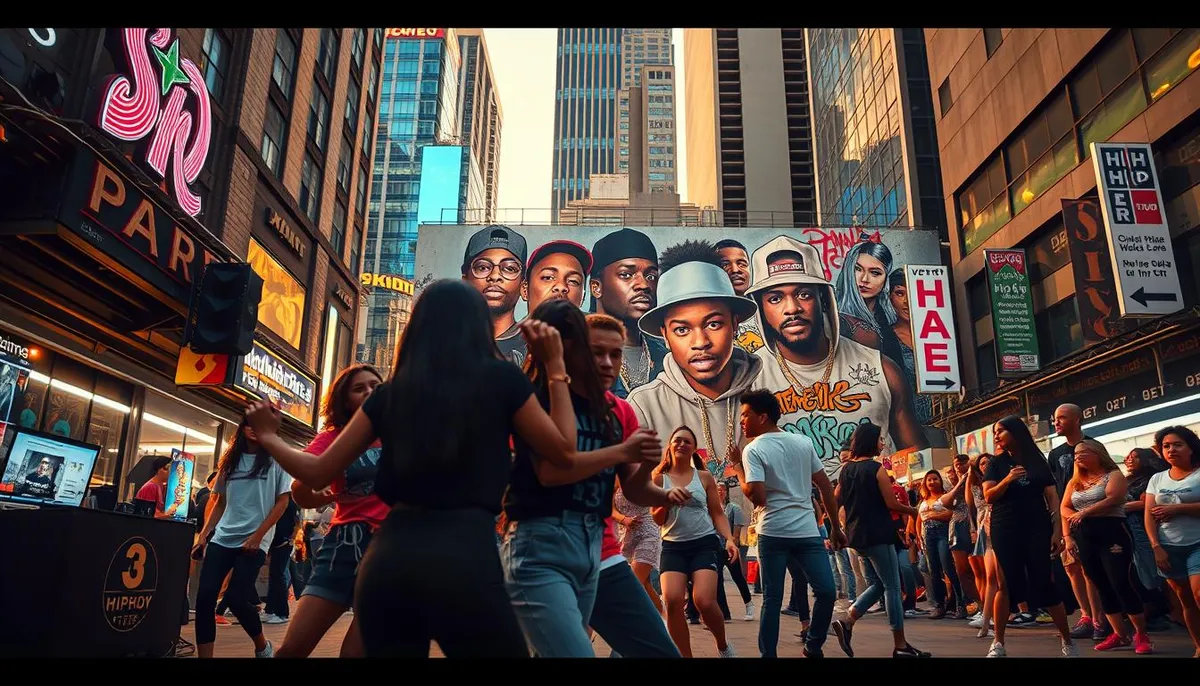
New Musical Trends
New musical trends in hip-hop are characterized by increasing diversity. Contemporary artists experiment with new sounds, incorporating elements from various musical genres. This creative fusion gives rise to innovative sub-genres that push the boundaries of traditional hip-hop music.
For example, the emergence of “trap” and “mumble rap” illustrates this evolution. These styles, originating from the United States, have quickly gained popularity worldwide, influencing hip-hop music production on a global scale.
- The integration of rhythms and melodies from other cultures.
- The use of advanced production technologies to create unique sounds.
- The collaboration between hip-hop artists and musicians from other genres.
The Role of Social Media in the Evolution of Hip Hop
Social media has revolutionized the way hip-hop is created, disseminated, and consumed. Platforms like YouTube, SoundCloud, and TikTok have become essential for hip-hop artists, allowing them to share their music with a global audience.
These platforms have also changed the game in terms of talent discovery. Independent artists can now gain recognition without the support of traditional labels, democratizing access to the global hip-hop scene.
The impact of social media on hip-hop is twofold: on one hand, they provide unprecedented visibility for artists; on the other hand, they pose challenges in terms of authenticity and diversity in an increasingly saturated media landscape.
Conclusion (500 words)
Hip-hop culture, born in the streets of the Bronx, has become a global phenomenon that continues to influence music, fashion, and art. Since its humble beginnings, hip-hop has evolved to become one of the most influential cultural movements of the 20th and 21st centuries.
Throughout the decades, hip-hop culture has demonstrated a unique ability to constantly reinvent itself while remaining true to its original spirit. From music to breakdance, through graffiti and rap, each element has contributed to shaping this cultural movement.
The influence of hip-hop culture on music is evident. It has given rise to new genres and allowed many artists to express themselves. Hip-hop has also had a significant impact on fashion, with luxury brands and designers integrating hip-hop style elements into their collections.
Hip-hop culture is more than just a musical or fashion movement; it is a social movement that has given a voice to marginalized communities. The development of company culture is reflected in how hip-hop artists have used their platform to address social and political issues, making this culture a catalyst for change.
As we look to the future, it is clear that hip-hop culture will continue to evolve and influence the world of music, fashion, art, and social movements. We invite readers to explore the richness and diversity of hip-hop culture in all its manifestations to fully understand its impact on our contemporary world. Additionally, for those interested in deepening their appreciation of film, learning how to become a film buff can provide a similar journey into understanding the nuances and artistry behind cinema.
In conclusion, hip-hop culture is a complex and dynamic phenomenon that has left an indelible mark on contemporary culture. Its influence on music, fashion, and art is undeniable, and its potential to continue shaping our culture is immense.
RelatedRelated articles


